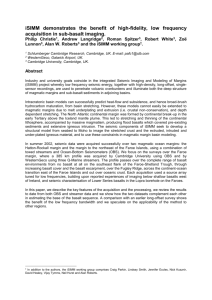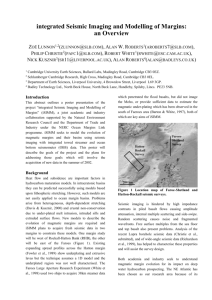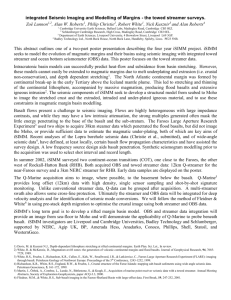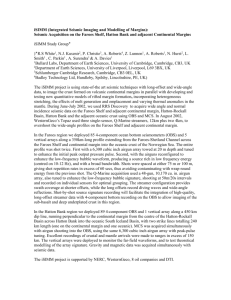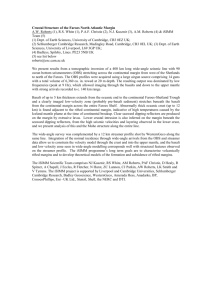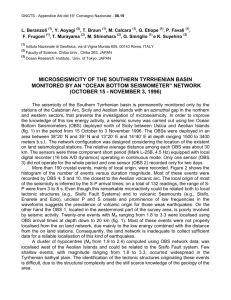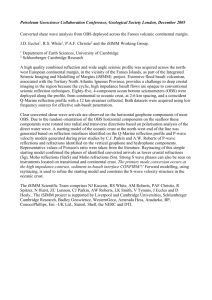Rewritten abstract - Badley Earth Sciences
advertisement
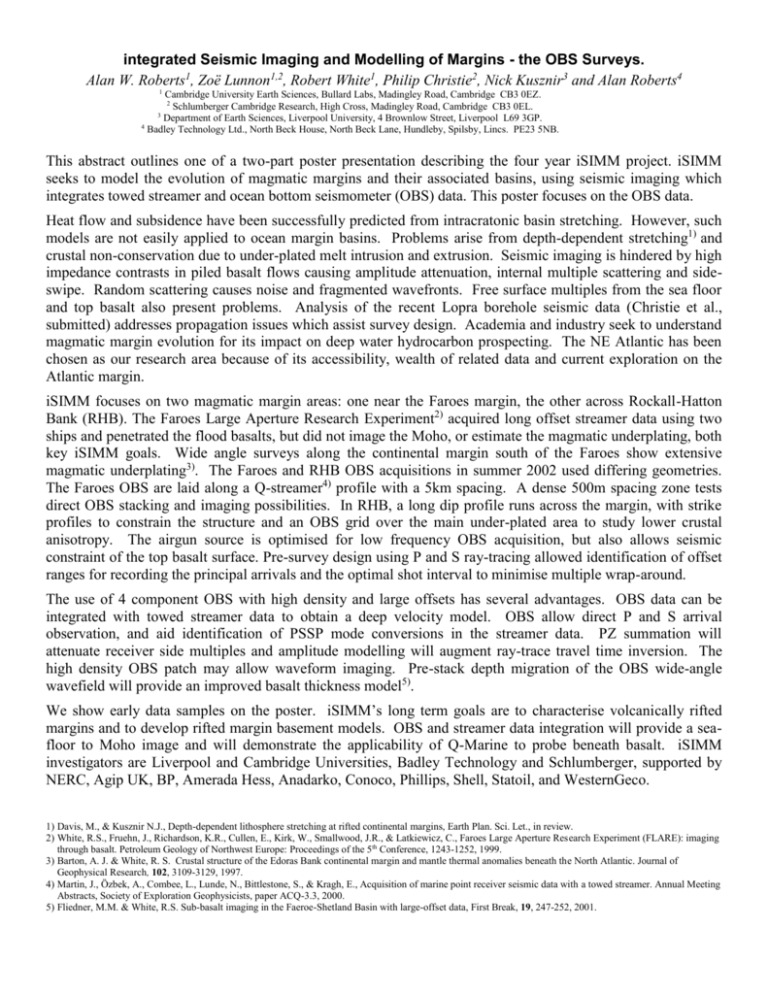
integrated Seismic Imaging and Modelling of Margins - the OBS Surveys. Alan W. Roberts1, Zoë Lunnon1,2, Robert White1, Philip Christie2, Nick Kusznir3 and Alan Roberts4 1 Cambridge University Earth Sciences, Bullard Labs, Madingley Road, Cambridge CB3 0EZ. 2 Schlumberger Cambridge Research, High Cross, Madingley Road, Cambridge CB3 0EL. 3 Department of Earth Sciences, Liverpool University, 4 Brownlow Street, Liverpool L69 3GP. 4 Badley Technology Ltd., North Beck House, North Beck Lane, Hundleby, Spilsby, Lincs. PE23 5NB. This abstract outlines one of a two-part poster presentation describing the four year iSIMM project. iSIMM seeks to model the evolution of magmatic margins and their associated basins, using seismic imaging which integrates towed streamer and ocean bottom seismometer (OBS) data. This poster focuses on the OBS data. Heat flow and subsidence have been successfully predicted from intracratonic basin stretching. However, such models are not easily applied to ocean margin basins. Problems arise from depth-dependent stretching1) and crustal non-conservation due to under-plated melt intrusion and extrusion. Seismic imaging is hindered by high impedance contrasts in piled basalt flows causing amplitude attenuation, internal multiple scattering and sideswipe. Random scattering causes noise and fragmented wavefronts. Free surface multiples from the sea floor and top basalt also present problems. Analysis of the recent Lopra borehole seismic data (Christie et al., submitted) addresses propagation issues which assist survey design. Academia and industry seek to understand magmatic margin evolution for its impact on deep water hydrocarbon prospecting. The NE Atlantic has been chosen as our research area because of its accessibility, wealth of related data and current exploration on the Atlantic margin. iSIMM focuses on two magmatic margin areas: one near the Faroes margin, the other across Rockall-Hatton Bank (RHB). The Faroes Large Aperture Research Experiment2) acquired long offset streamer data using two ships and penetrated the flood basalts, but did not image the Moho, or estimate the magmatic underplating, both key iSIMM goals. Wide angle surveys along the continental margin south of the Faroes show extensive magmatic underplating3). The Faroes and RHB OBS acquisitions in summer 2002 used differing geometries. The Faroes OBS are laid along a Q-streamer4) profile with a 5km spacing. A dense 500m spacing zone tests direct OBS stacking and imaging possibilities. In RHB, a long dip profile runs across the margin, with strike profiles to constrain the structure and an OBS grid over the main under-plated area to study lower crustal anisotropy. The airgun source is optimised for low frequency OBS acquisition, but also allows seismic constraint of the top basalt surface. Pre-survey design using P and S ray-tracing allowed identification of offset ranges for recording the principal arrivals and the optimal shot interval to minimise multiple wrap-around. The use of 4 component OBS with high density and large offsets has several advantages. OBS data can be integrated with towed streamer data to obtain a deep velocity model. OBS allow direct P and S arrival observation, and aid identification of PSSP mode conversions in the streamer data. PZ summation will attenuate receiver side multiples and amplitude modelling will augment ray-trace travel time inversion. The high density OBS patch may allow waveform imaging. Pre-stack depth migration of the OBS wide-angle wavefield will provide an improved basalt thickness model5). We show early data samples on the poster. iSIMM’s long term goals are to characterise volcanically rifted margins and to develop rifted margin basement models. OBS and streamer data integration will provide a seafloor to Moho image and will demonstrate the applicability of Q-Marine to probe beneath basalt. iSIMM investigators are Liverpool and Cambridge Universities, Badley Technology and Schlumberger, supported by NERC, Agip UK, BP, Amerada Hess, Anadarko, Conoco, Phillips, Shell, Statoil, and WesternGeco. 1) Davis, M., & Kusznir N.J., Depth-dependent lithosphere stretching at rifted continental margins, Earth Plan. Sci. Let., in review. 2) White, R.S., Fruehn, J., Richardson, K.R., Cullen, E., Kirk, W., Smallwood, J.R., & Latkiewicz, C., Faroes Large Aperture Research Experiment (FLARE): imaging through basalt. Petroleum Geology of Northwest Europe: Proceedings of the 5th Conference, 1243-1252, 1999. 3) Barton, A. J. & White, R. S. Crustal structure of the Edoras Bank continental margin and mantle thermal anomalies beneath the North Atlantic. Journal of Geophysical Research, 102, 3109-3129, 1997. 4) Martin, J., Özbek, A., Combee, L., Lunde, N., Bittlestone, S., & Kragh, E., Acquisition of marine point receiver seismic data with a towed streamer. Annual Meeting Abstracts, Society of Exploration Geophysicists, paper ACQ-3.3, 2000. 5) Fliedner, M.M. & White, R.S. Sub-basalt imaging in the Faeroe-Shetland Basin with large-offset data, First Break, 19, 247-252, 2001.
